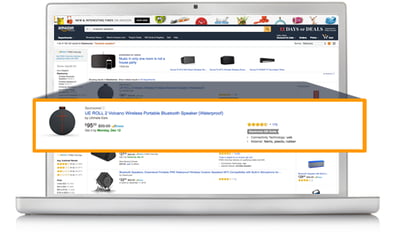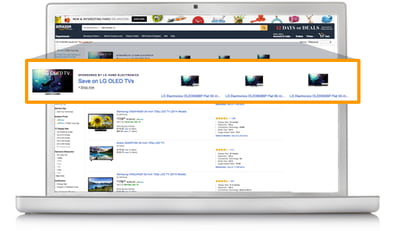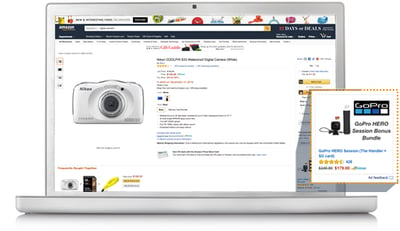
Summary: When your name is synonymous with ecommerce shopping, you know that your brand is doing a lot of business. And in this article, we dive into the three types of Amazon ad types: what they are, how they work, and who can leverage them.
The benefit of Amazon’s marketing is illustrated in its most recent financial results. It is the third-largest digital advertising platform in North America after Google and Facebook. And in 2021, Amazon had the highest-selling Black Friday to Cyber Monday shopping weekend ever, with clothing, beauty, home, and toys amongst the top-selling categories.
According to Amazon, in the period between Black Friday and Christmas, U.S-based third-party sellers sold an average of 11,500 products per minute. And Amazon collected $31.16 billion in advertising revenue from sellers on its platform.
With all this potential opportunity, the instinct to get started with Amazon Ads is powerful. But digital marketing on Amazon has its challenges. For example, Amazon does not share customer information with marketers, making it challenging to market to these customers in the future. And advertising on other platforms like Google or Facebook can be difficult when Amazon is your primary ecommerce platform.
But despite all this, the reach and scope of Amazon means that since this is where the customers are, this is where marketers should be. So here’s what you need to know about Amazon Ads and how you can get started.
Three Main Amazon Ad Types
Amazon has three main advertisement types (or ad products) that you access through Amazon Ads. They are Sponsored Products, Sponsored Brands, and Sponsored Displays. These ads are all available for use for Amazon PPC, which is a pay-per-click or cost-per-click (CPC) advertising format, so you only pay when customers click on your ad.
Like Google, Amazon uses an auction-based system that allows advertisers to place bids to display to shoppers. Here are some suggestions for getting the most out of your chosen Amazon PPC ads:
- Know your Amazon Cost of Sale: ACoS = advertising spend divided by sales
- Use the correct keywords and/or targeting strategy to promote your products.
- Monitor your results to know what you should keep doing and stop.
- Be patient. Getting results will take time.
- Be fearless in re-evaluating your strategy.
Amazon Sponsored Product Ads
Sponsored Products are Amazon advertisements that promote a single product. Because it is only one product, no copy or graphics are needed. Instead, the product listing is used to set up the advertisement to start running quickly. Advertisers then use keywords to target customers.

Amazon has a set of allowable product categories to use Sponsored Products advertisements. And besides falling within the permissible category, products must also be eligible for the Buy Box, the section on the right side of the Amazon product detail page, to be visible as a Sponsored Product.
The categories that are not allowed to use Sponsored Products are adult products, used products, refurbished products, and products in closed/gated/restricted categories. And this last category requires explicit Amazon approval to sell.
Only certain parties can use Sponsored Products ads. These include professional sellers, vendors, book vendors, Kindle Direct Publishing (KDP) authors, and agencies. In addition, there are specific locations where Sponsored Products can appear—at the top of search results, alongside or within search results, and on product pages.
Amazon Sponsored Brand Ads
Sponsored Brand Ads are Amazon advertisements that promote up to three products and an Amazon store, with targeted keywords to attract customers. Sponsored Brands create brand awareness with customers researching their product options, which leads to product sales.
These ads are large banner advertisements at the top of an Amazon search results page. It includes a brand logo, a personalized tagline, and multiple examples of products that correspond with the selected keywords.

Since the advertisement is brand-focused, it includes a link that takes the customer to a custom landing page or the brand’s own Amazon Store. Within the Amazon Store, customers can browse only the products of a specific brand, and the brand owner also chooses what they want to feature in their Amazon Store. And best of all – it’s free from competitors’ products and advertisements.
Products advertised through Sponsored Brands must be new and not fall under the adult, used, or refurbished categories. The parties allowed to use Sponsored Brands are professional sellers in the Amazon Brand Registry program, vendors, book vendors, and agencies. Sponsored Products appear at the top of search results, alongside or within search results.
Amazon Sponsored Display Ads
Sponsored Display promotes a single product and targets customers based on their shopping activities within Amazon, regardless of whether a product is viewed or purchased. It does not use keywords but one of two different targeting options: Product Targeting or Audiences. Automation and machine learning drives sales of these promoted products.
With Product Targeting, a product is promoted among audiences actively researching similar products or categories. These Sponsored Display advertisements will appear on Amazon product detail pages and/or search results pages.

Advertisements with the Audience targeting option appear on the Amazon home page, product detail pages, product search results pages, and third-party websites and apps.
A comprehensive list of products that can be promoted is on the Amazon website. Prohibited products for Sponsored Display advertisements include adult products, alcohol, prescription drugs, and devices—also, weapons such as pepper spray, fireworks, and airsoft guns. Sponsored Display is only available to parties in the Amazon Brand Registry, vendors, and agencies with clients who sell products on Amazon.
In Conclusion
With Amazon and ecommerce shopping growing by leaps and bounds, staying on top of crucial ad opportunities is vital for any well-run business. We hope this summary of Amazon’s different ad types was helpful.
Be sure to reach out to WSI to help your business with your ecommerce and marketing needs. We can help you with Amazon marketing—and everything digital marketing!
About the Author
Rick spent 20 years in the insurance industry in finance, primarily developing reporting platforms for B & C stakeholders. His ability to speak to consumers of data (managers and analysts) and translate their needs to programmers led him to start his own digital marketing agency in 2004 to develop data driven solutions for business owners.
The Best Digital Marketing Insight and Advice
We are committed to protecting your privacy. For more info, please review our Privacy and Cookie Policies. You may unsubscribe at any time.
Don’t stop the learning now!


